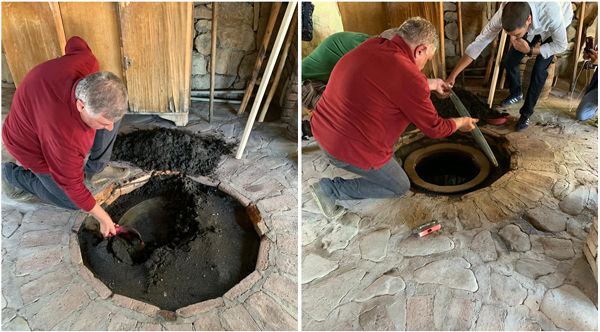
The Caucasus Mountains as viewed from the Tsinandali Estate
Our next stop was then the main winemaking region of Kakheti, about 2 hours northeast of the capital. This was proper winemaking country; endless wineries and vines and, as it was harvest, lorryloads of grapes being driven around. This region is split in two by the Alazani river, forming a Left Bank and a Right Bank. The identification and understanding of soils here is still very much a work in progress (you must constantly remind yourself that there’s only been 20 years of true quality-minded winemaking here, as under Soviet rule it was all about quantity). There are very black slates that come down from the mountains and spread through the valley by the river, with pockets of clay with limestone – all helping to give structure to the wines in this warm region.

Source: Wines of Georgia
Shilda, Tiko Estates & Winery Khareba
We went to the Left Bank, arguably fresher as closer to the Caucasus mountains and PDOs here not insisting on oak aging, to the Shilda and Tiko Estates. Shilda is a real up-and-comer, great value for money to be found in their Kakabadze range, while Tiko, made by Ukrainian born Levan, are as close to a White Burgundy made in Georgia as you’ll find. The Tiko wines are already in the UK, and I’d advise you to seek them out or order if spotted on a wine list.

Shila Estate with the Caucasus Mountains behind
It was then to Winery Khareba, with their old wine tunnels and own traditional polyphonic choir. We were also invited to help in harvest (note to self – must put ‘done a harvest’ on the CV now) and press our freshly picked grapes in a traditional lagar-like press known as a satsnakheli.
A simply enormous producer making around 6 million bottles a year, it was fascinating to see what domestic markets and other export markets are buying. Although not entirely to this author’s taste, the vision and objective of this estate is admirable and impressive.
Twins Winery

Opening up the Qvevri at Twins. The black sand sealing the top is removed, and then the glass seal is opened up to reveal the amber liquid inside.
The next day brought a real highlight of the trip in the form of a visit to the Twins winery. Established in 2005 by, shockingly, 2 twins, Gia and Gela, this was one of the most eye-opening and informative visits yet.
A very useful cross section of a Qvevri showed fermentation in process and we were fortunate to have a Qvevri of their Khikhvi opened up for us. It was simply awesome. Not a million miles away from an energising and invigorating GG Spätlese Riesling – this amber liquid was just amazing. Then, they pulled out a 2012 Rkatsiteli made in Qvevri that was mind-blowing. Tasting like an aged White Burgundy, full of a gentle nuttiness, this felt like a truly special experience. They were also kind enough to give us our first taste of chacha, the local grappa, the first of many to come…!
Qvervri making
We were then fortunate to pop over and see the Qvevri maker known simply as ‘Zaza’. One of only 3 Qvevri makers in Georgia, he was kind enough to let us in whilst in the middle of his lunch.

Zaza and his Qvevri. On the right: half finished Qvevri in the process of being made, built from the ground up.
A quick note: these are not the same as amphorae, which are technically wine transportation vessels and much smaller. Qvevri are wine fermentation vessels, and in Kakheti, are roughly 2.5m tall and capable of holding 2000l. They are made layer by layer – snakes of clay are rolled out and added to the Qvevri upwards. Once made, they are then fired in his kiln, reaching around 1000 degrees centigrade. Zaza only makes around 16 Qvevri a year, with a wait list of 2+ years; and eye-opening fact when thinking about how rapidly the market is growing here.
Browse our Georgian wines here
Feels like visiting Georgie just by looking at your posts.